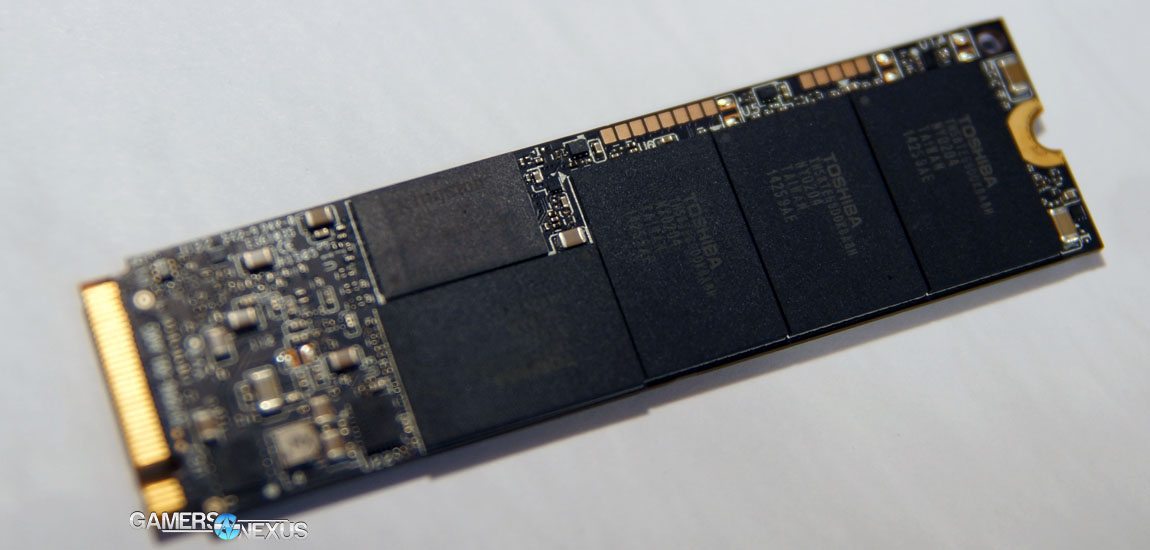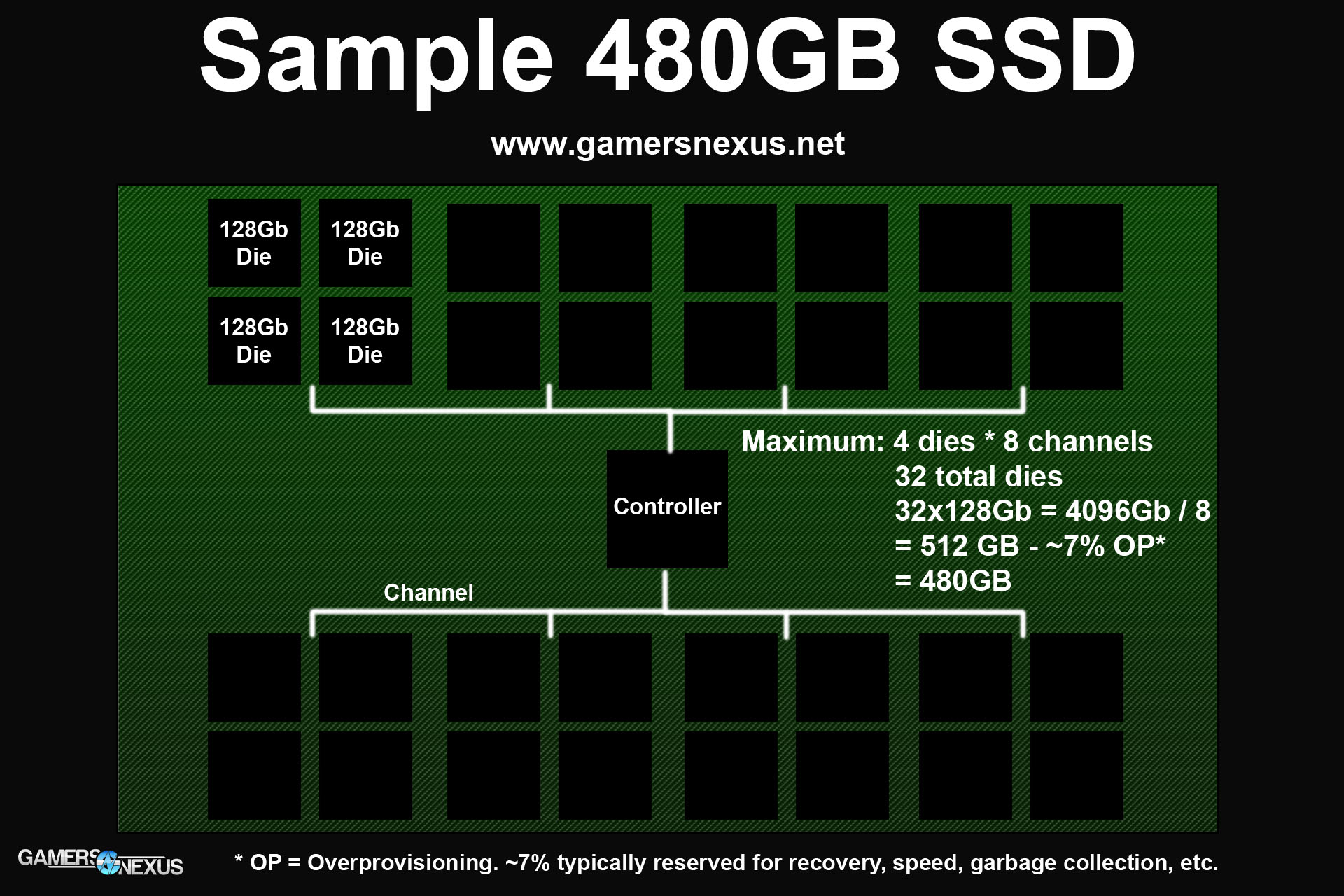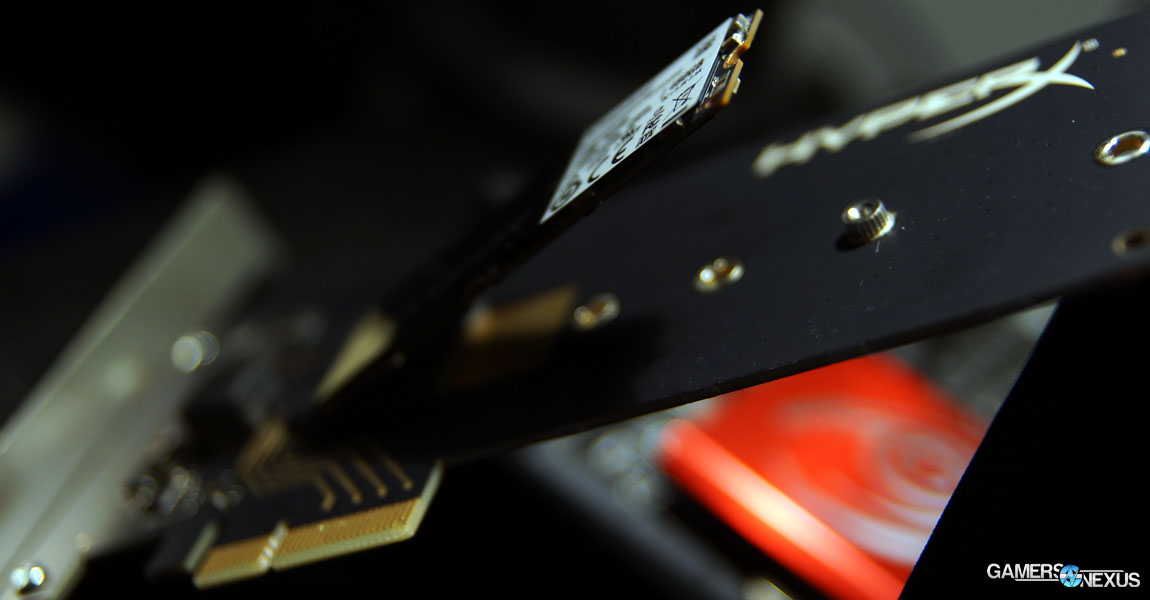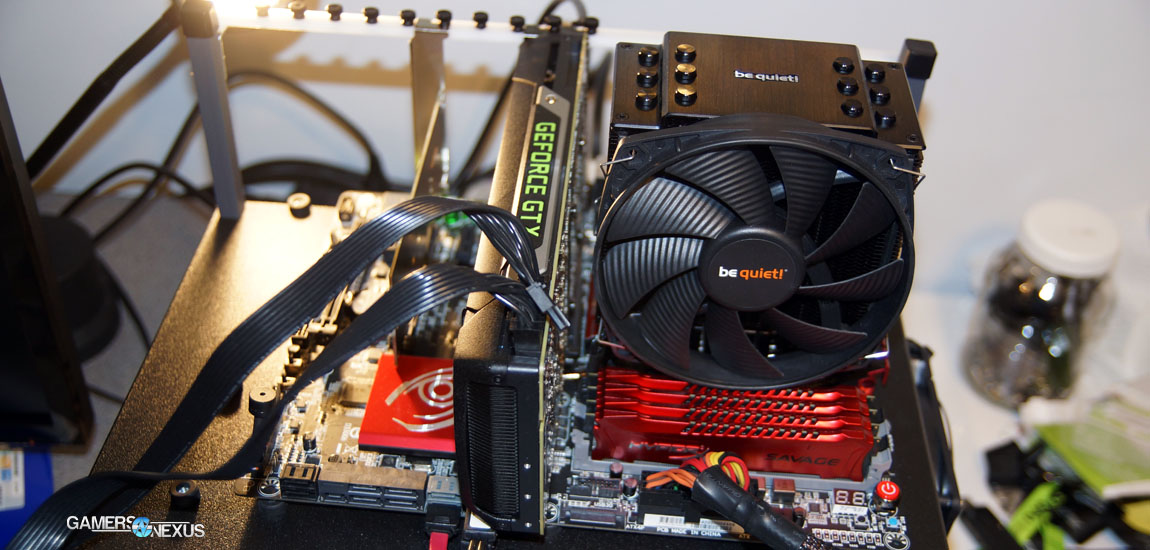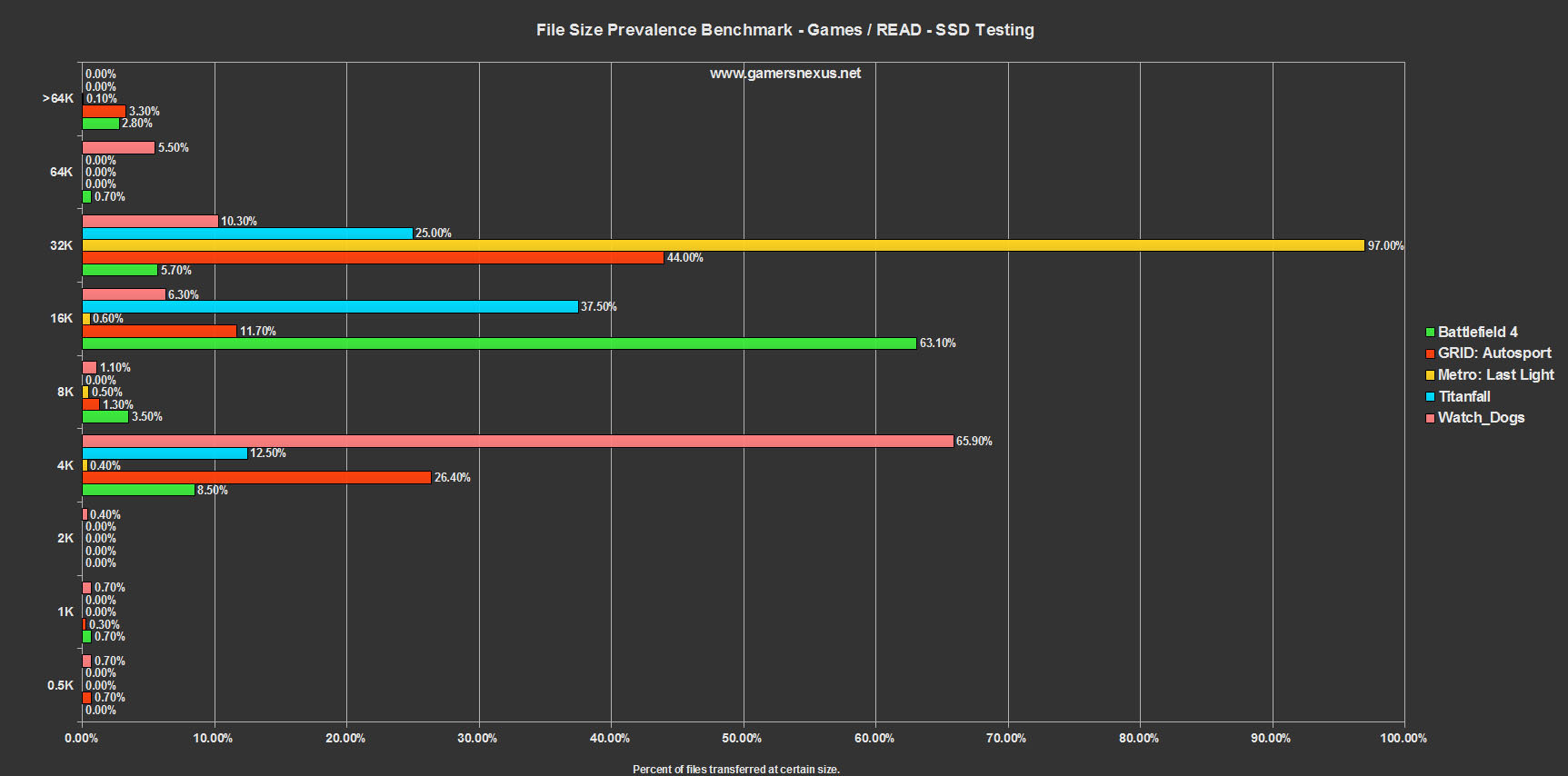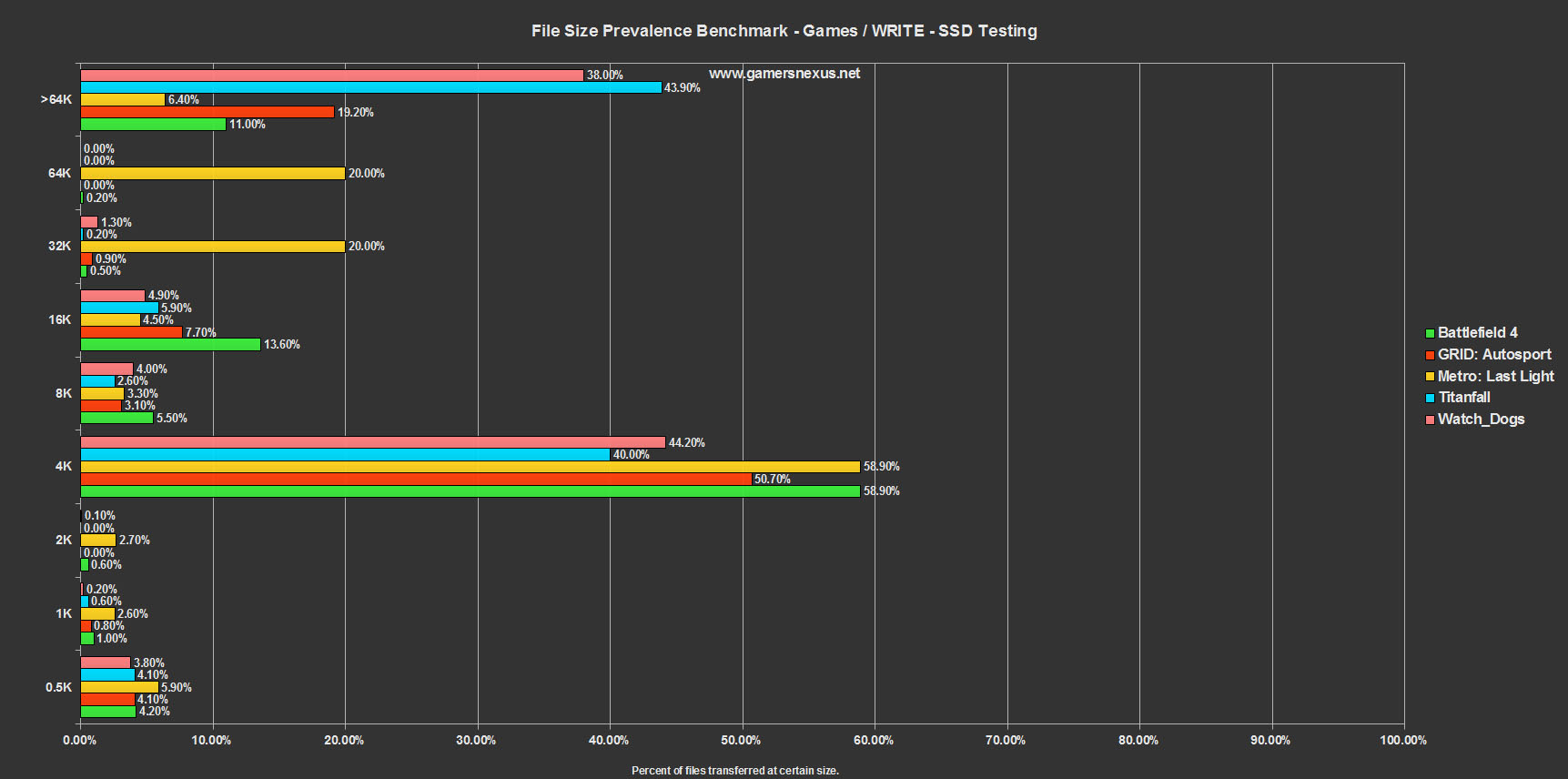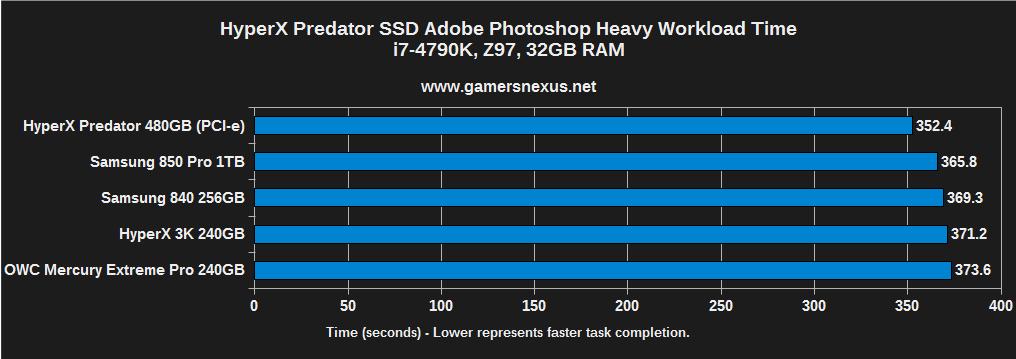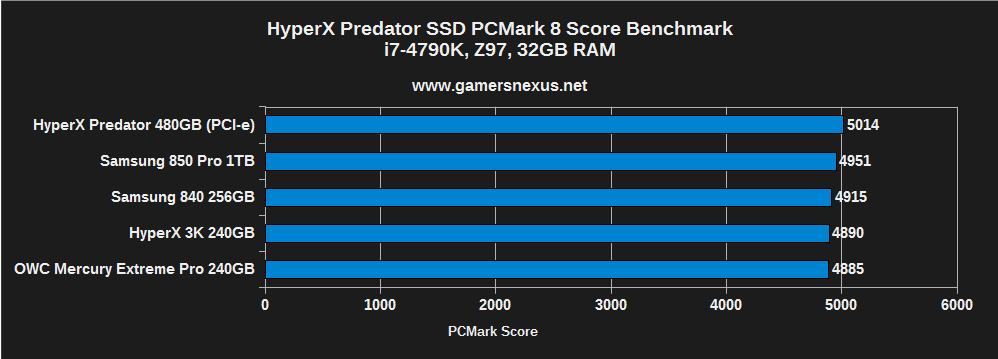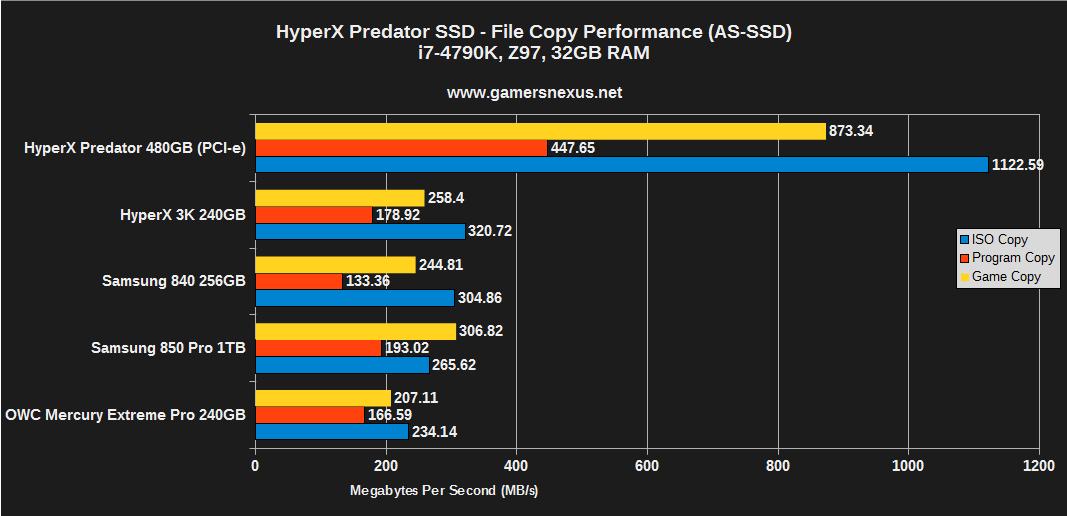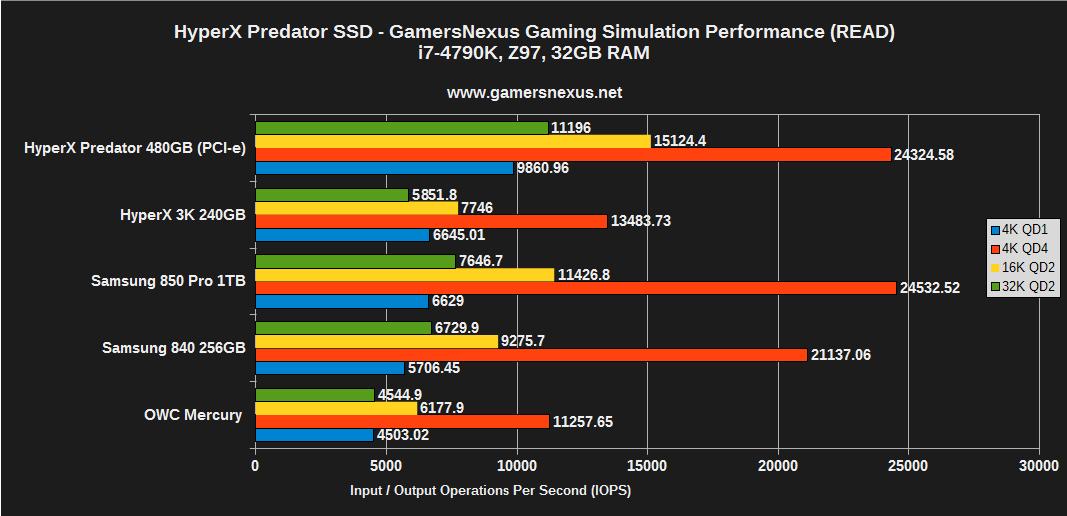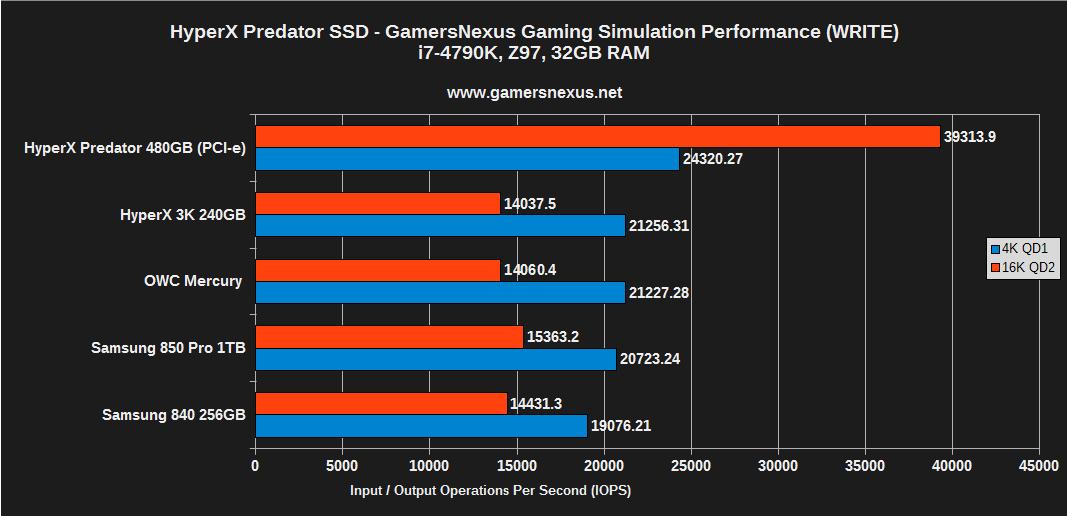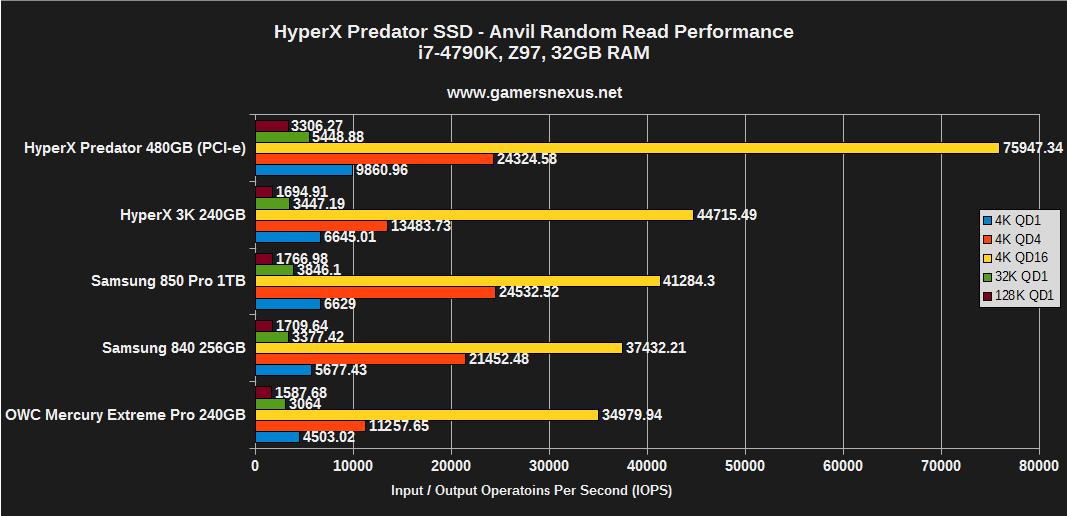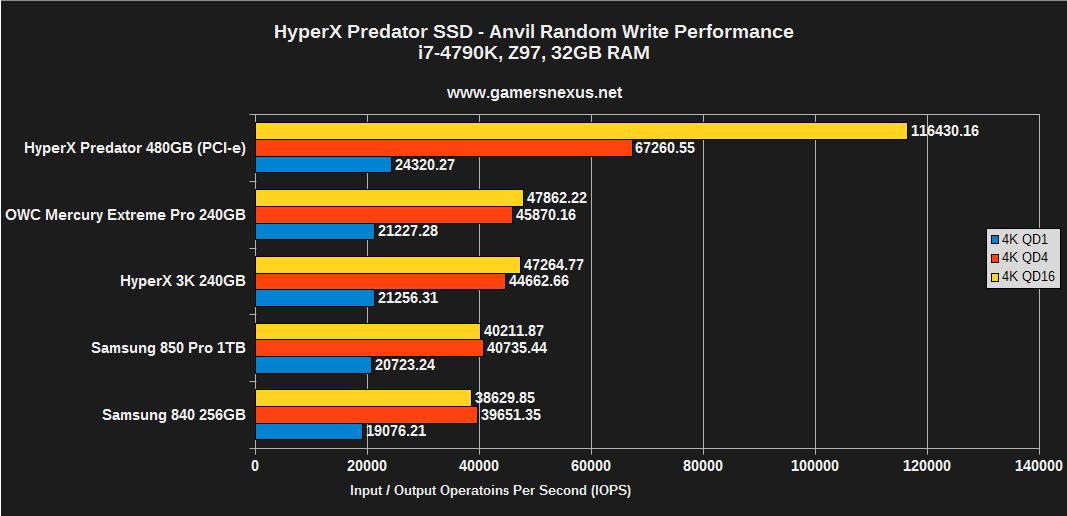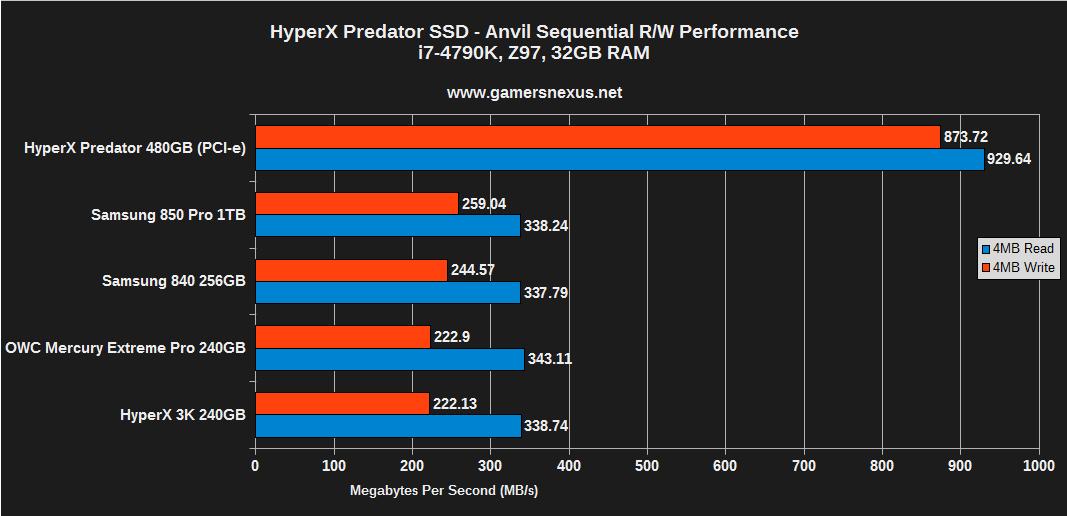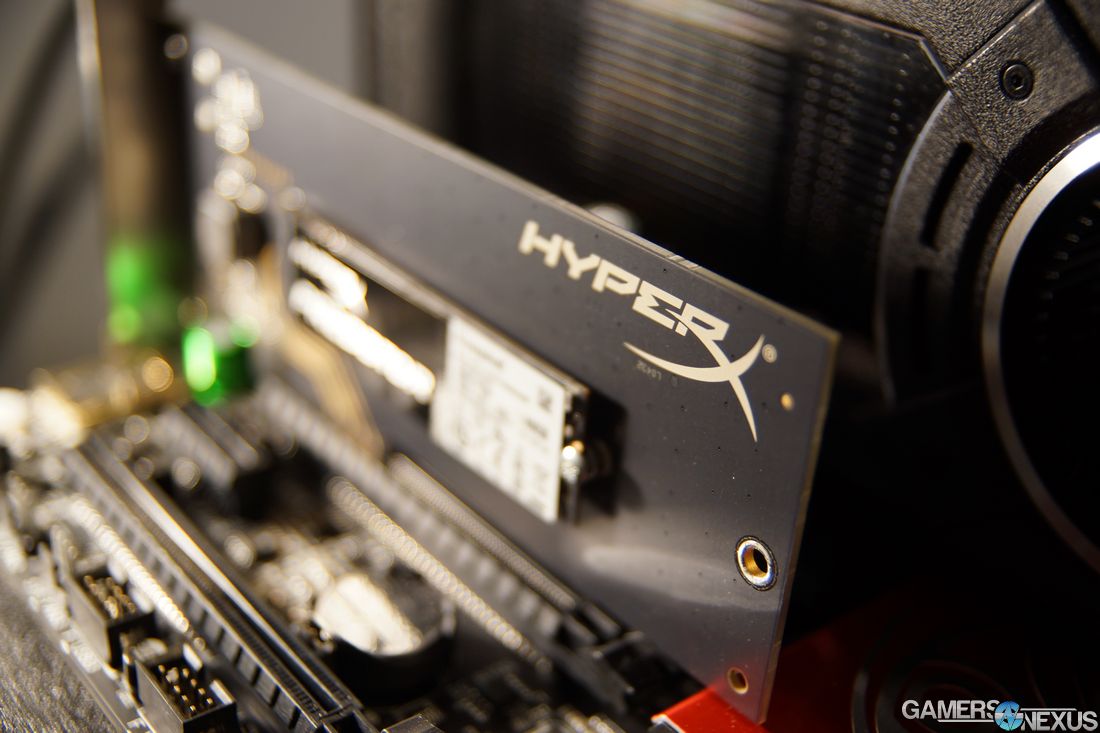HyperX Predator PCI-e SSD Review - Analyzing the Practicality of 1.4GB/s
Posted on April 6, 2015
The first consumer-priced PCI-e SSDs are finally trickling to market. OCZ's RevoDrive was one of the only consumer-facing PCI-e SSDs, priced out of range for most gamers and facing somewhat widespread endurance and stability issues as the device aged. During a period of SandForce domination, the industry waited for the third-generation refresh of the SF controllers to introduce widespread PCI-e SSDs. The third gen controllers promised what effectively would act as an interface toggle, allowing manufacturers to purchase a single controller supply for all SATA and PCI-e SSDs, then “flip the bit” depending on demand. Such an effort would reduce cost, ultimately passed on to the user. This controller saw unrelenting delays, giving rise to alternatives in the meantime.
Then M.2 became “a thing,” bringing smaller SSDs to notebooks and desktops. The M.2 standard is capable of offering superior throughput to SATA III (6Gbps) by consuming PCI-e lanes. Pushing data through the PCI-e bus, M.2 devices circumnavigate the on-board SATA controller and its abstraction layers, responsible for much of the overhead showcased in peak 550MB/s speeds. The M.2 interface can operate on a four-lane PCI-e 2.0 configuration to afford a maximum throughput of 2GB/s (before overhead), though – as with all interfaces – this speed is only awarded to capable devices. Each PCI-e 2.0 lane pushes 0.5GB/s (GT/s). Some M.2 devices utilize just two PCI-e lanes, restricting themselves to 1GB/s throughput but freeing-up the limited count of PCI-e lanes on Haswell CPUs (16 lanes from the CPU, up to 8 lanes from the chipset).
Haswell-E devices offer upwards of 40 PCI-e lanes, ensuring availability for devices without throttling when using a non-adapted M.2 SSD.
(Note: Consider reading our SSD Architecture post to better understand NAND, controllers, & more).
The HyperX PCI-e Predator SSD is fairly simple in its execution: Kingston packaged its M.2-2280 Predator SSD with a PCI-e adapter card (about $10 more), which runs traces from the M.2 disk to the PCI-e interface on a matte black PCB. The adapter hosts little logic, with the modular and user-serviceable M.2 SSD standing solely responsible for all the solid-state technology, including the NAND Flash and SSD controller. To this end, Kingston's adapter solution is an interesting one, bolstered by the allowance of user service to the M.2 disk; if a user later upgraded to an M.2 motherboard, it'd be easy to ditch the card and move to an M.2 host interface. Kingston isn't the only company that's caught on to this, either – ADATA, Plextor, and PNY could all be working on similar devices, based on past discussion.
Then there are native PCI-e SSDs more akin to the old RevoDrive, like Intel's new 750 NVMe SSD ($470) that hosts the NAND and controller on the actual expansion card. We hope to review similar competing devices in the near future.
This review benchmarks Kingston's new HyperX PCI-e Predator SSD against existing SATA solutions like the 850 Pro. We look at Photoshop workloads, gaming performance, file copy workloads, and more. Until we've received review samples of competing PCI-e SSDs, we can't make a direct comparative analysis of same-interface devices. In the meantime, you'll get an idea for performance and speed offered by M.2 via PCI-e.
HyperX PCI-e Predator SSD Specs
| Interface | M.2 SSD with PCI-e 2.0 x4 adapter HHHL PCI-e Modular M.2 SSD |
| Controller | Marvell Altaplus 88SS9293 |
| Initial NAND | Toshiba Toggle A19 64Gbit 19nm MLC |
| Capacities | 240GB 480GB |
| Advertised Speeds | Random 4k Read/Write (480GB model) Read: 117K 4K IOPS Write: 70K 4K IOPS Incompressible Sequential R/W (480GB) Read: 1100MB/s Write: 910MB/s Max Advertised Speed Read: 1.4GB/s compressible (ATTO) Write: 1GB/s compressible (ATTO) |
| TDP (Power Consumption) | 1.38W Idle 1.4W Avg / 1.99W (MAX) Read 8.25W (MAX) Write |
| Prices | 240GB Predator M.2 Standalone - $231 480GB Predator M.2 Standalone - $470 240GB Predator PCI-e SSD - $242 480GB Predator PCI-e SSD - $470 |
| Availability | Presently available NVIDIA GTX Titan X, but lower prices anticipated soon. |
The street price of the Predator PCI-e SSD is expected to stand below $1/GB, likely listing close to the following numbers:
- 240GB HyperX Predator M.2 Standalone - $231
- 480GB HyperX Predator M.2 Standalone - $470
- 240GB HyperX Predator M.2 HHHL Adapter - $242
- 480GB HyperX Predator M.2 HHHL Adapter - $470
Some devices are already listed on Amazon by Kingston's official account, though retailers are expected to sell the cards at lower prices in short order.
Device Architecture
The new SSD deviates from a previous SandForce allegiance – though does not preclude concurrent SandForce utilization – and opts for Marvell's 88SS9293 controller. Plextor is using the same controller in its M7e M.2 SSD, showcased at CES simultaneously with the HyperX Predator.
Marvell's Altaplus 88SS9293 (“*9293”) controller is a four-lane, eight-channel flash processor built for the M.2 market. The controller supports capacities not exceeding 512GB in M.2, ensuring a capacity ceiling that the Predator will not immediately exceed (though increases in capacity are expected). The X4 controller is compatible with 1ynm MLC NAND (see: NAND Types definition).
Unlike the SandForce FSPs, Marvell does not show favor toward certain data types – like compressible or incompressible data – and has less focus on data entropy.
The HyperX SSD's initial sample hosts Toshiba A19 (19nm) Toggle NAND, a 64-gigabit die with four Flash modules on the PCB. Here's an image from our SSD architecture post that helps explain how a generic eight-channel controller communicates with the Flash modules:
Note that the above is using a sample architecture, so it is not the same as this SSD. The anatomy is the same, though.
SATA Interface Limitations
The demand for an alternative to SATA comes at a time when SATA III SSDs are meeting the after-overhead limitations of the interface, resting approximately around 550MB/s. At this point, even mid-range SSDs perform effectively identically to high-end units like the 850 Pro when strictly considering speed; to this end, speed is no longer a differentiating factor in SATA SSD selection, giving way to endurance and security features.
As X4 controllers have rolled-out to M.2 SSDs, we again see the interface allow headroom for improvement in speed, reviving a critical differentiating performance metric for comparison. NVMe SSDs, like Intel's impending 750, boast similarly increased interface throughput that forces the device to be the chokepoint for performance, not the interface itself.
High-end devices – again, like the 850 Pro – offer encryption methods and business-class data protection features to justify a higher price point. Endurance is among the most important metrics to consider when selecting an SSD, but the nature of endurance testing effectively ensures it is impossible for longevity analysis in time for an initial review. We would recommend Tech Report's now-concluded SSD Endurance Test for further information on this front. We can base endurance projections and speculation on controller and NAND selection, but other aspects – like firmware and electrical components – also impact lifetime of the device.
What does the PCI-e Adapter Do For Me that M.2 Doesn't?
Users with a capable M.2 motherboard may instead find themselves considering an M.2 unit without an adapter. In these instances, it has been shown through testing that some Z97 configurations yield lower M.2 performance than PCI-e performance, showing that X99 systems with greater lane availability to M.2 devices yield the most comparable performance to the PCI Express-adapted SSD.
Those without M.2 ports on the board see immediate and obvious gains: The PCI-e adapter brings M.2 speed SSDs to a system which could otherwise not natively support them, consuming a PCI-e port in the process. This eliminates usability in most micro-ATX or mini-ITX motherboards that need the slot for a video card, but given the relatively high count of PCI-e slots on ATX boards, makes for an easy, high-speed storage solution without eating into components too deeply. The ability to expand into lane-intensive SLI/CrossFire is diminished when assigning four of the 24 available Z97 lanes to an SSD, though multiplexed boards would make more allowances for such configurations.
Please continue to page 2 for test methodology and benchmark results.
Test Methodology
GamersNexus has performed extensive studies of SSD file and I/O usage in real-world use case scenarios, primarily gaming and video production environments. We have also worked closely with controller manufacturers to educate ourselves on various strengths and weakness of competing controllers, helping to build our SSD test methodology. Our test cases and methodology have been peer-reviewed by Kingston, Samsung, LSI / SandForce, and other experts in the industry.
One of our published studies analyzed the number of I/O requests made when playing various games, from which we've reproduced some of the charts below:
| Statistics | 0.5K | 1K | 2K | 4K | 8K | 16K | 32K | 64K | <=64K | Total Transfer |
| BF4 Read | 0 | 0 | 0 | 12 | 5 | 89 | 8 | 1 | 137 | 3.2MB |
| BF4 Write | 26 | 6 | 4 | 357 | 34 | 84 | 3 | 1 | 543 | 67.3MB |
| GRID: Autosport Read | 2 | 1 | 0 | 81 | 4 | 36 | 135 | 0 | 296 | 7.2MB |
| GRID: Autosport Write | 56 | 11 | 0 | 685 | 42 | 104 | 11 | 0 | 1090 | 66.4MB |
| Metro: LL Read | 0 | 0 | 0 | 42 | 47 | 58 | 10003 | 1 | 10294 | 320MB |
| Metro: LL Write | 72 | 31 | 33 | 709 | 40 | 50 | 1 | 1 | 1112 | 77.8MB |
| Titanfall Read | 0 | 0 | 0 | 1 | 0 | 3 | 2 | 0 | 8 | 156KB |
| Titanfall Write | 26 | 4 | 0 | 251 | 16 | 37 | 1 | 0 | 352 | 274MB |
| Watch_Dogs Read | 5 | 5 | 3 | 478 | 8 | 46 | 75 | 40 | 725 | 9.2MB |
| Watch_Dogs Write | 34 | 2 | 1 | 395 | 36 | 44 | 12 | 0 | 555 | 156MB |
This analysis helped understand that, while 4K random performance is still significant, games have also begun making numerous 16KB read/write and 32KB read I/O requests during loading and gameplay. Further analysis revealed that many games do not exceed a queue depth of two, with most 4KB random transactions still resting at QD1. This is reflected in our ensuing tests.
We conduct tests using these software utilities:
- PCMark 8 real-world trace testing of Adobe, gaming, and Office software.
- AS-SSD & AS-SSD copy simulation.
- ATTO (often left unpublished and used strictly for validation).
- Anvil's Storage Bench.
- IOmeter for preconditioning.
- HD Tune Pro for I/O analysis and drive consistency.
- CrystalDiskInfo for component validation.
All devices host a local copy of Windows 8.1. This is critical to our benchmarks, which will report lower measurements than tests which are conducted from a separate host SSD. All of our tests are conducted locally on the DUT (device under test) from an imaged, clean install of Windows 8.1 that strictly hosts the SSD test utilities and device drivers. We have observed what we deem unrealistic performance gains when testing SSDs from an independent host; installing a separate OS on each device ensures a better representation of a real use case, as we benchmark on the assumption that the majority of our users will deploy their SSD as the host drive.
All storage drivers are independently validated prior to benchmarking.
Every SSD is secure erased prior to test initialization. This ensures that the device is representative of its factory-clean state. The image is then deployed to the device, at which point we issue a custom IOmeter protocol to precondition the drive pursuant to its capacity (0.50min * capacity = precondition duration). Preconditioning metrics are noted at the start and end of each test for validation purposes, often reflecting a marginal decline in performance and eventual stabilization toward the end of the test. Preconditioning the device produces the most realistic user scenario as SSDs will overperform when fresh out-of-box, and are volatile in performance at the very beginning of life such that test results would otherwise be invalidated.
Additional steps are taken to ensure stability and validation of results. Some in-house utilities are deployed. Further test procedures are kept in-house for competitive reasons.
All tests are conducted multiple times for parity. Results are averaged. Peak speeds are discarded as outliers.
Anvil tests are modified to 67% compression for more representative benchmarking.
Some test execution is automated with batch files or in-house scripting, then logged using automated processes. This ensures data consistency and rapid test execution, permitting a higher sample of test runs for parity.
| GN Test Bench 2015 | Name | Courtesy Of | Cost |
| Video Card | NVIDIA | $1000 | |
| CPU | Intel i7-4790K CPU | CyberPower | $340 |
| Memory | 32GB 2133MHz HyperX Savage RAM | Kingston Tech. | $300 |
| Motherboard | Gigabyte Z97X Gaming G1 | GamersNexus | $285 |
| Power Supply | NZXT 1200W HALE90 V2 | NZXT | $300 |
| SSD | HyperX Predator PCI-e SSD | Kingston Tech. | $470 |
| Case | Top Deck Tech Station | GamersNexus | $250 |
| CPU Cooler | Be Quiet! Dark Rock 3 | Be Quiet! | ~$60 |
Waiting on Other PCI-e SSDs
This is the very first PCI-e SSD we've tested of this generation, so it rests lonely in the benchmark against effectively non-competing SATA SSDs. We're awaiting samples of SSDs that are finalizing development from other manufacturers, but until a point at which these are made available, the HyperX Predator stands alone.
Our benchmarks provide an early look at the advantages yielded by modern PCI-e consumer SSDs, but note well that other PCI-e SSDs could come along that outpace the Predator in the coming months.
PCMark 8 – Adobe Photoshop Workload Benchmark
Using PCMark 8's trace-based benchmarking, we're able to realistically simulate real-world performance of Adobe software in a replicable fashion. The traces executed include I/Os with known start/end I/O timing, starting LBA, and length of the I/O in bytes. Idle time compression has been removed from PCMark 8, ensuring more accurate representation of the real application.
Storage traces for the below Photoshop tests were played back with the following attributes:
| Photoshop Light | up to 4096 | up to 64K | up to 128K | Total | 4K Aligned % |
| Sequential reads | 479 | 680 | 349 | 1508 | 68.83% |
| Random reads | 8215 | 9249 | 61 | 17525 | 68.25% |
| Sequential writes | 223 | 861 | 17258 | 18342 | 99.91% |
| Random writes | 214 | 246 | 1283 | 1743 | 99.20% |
| Photoshop Heavy | up to 4096 | up to 64K | up to 128K | Total | 4K Aligned % |
| Sequential reads | 706 | 3288 | 283 | 4277 | 88.05% |
| Random reads | 8980 | 9623 | 52 | 18655 | 68.94% |
| Sequential writes | 250 | 904 | 43588 | 44742 | 100% |
| Random writes | 440 | 208 | 1417 | 2065 | 98.64% |
All this known, here's our benchmark:
Execution time for the Predator SSD excelled against nearby competition, including the Mac/Workstation-targeted Mercury Extreme Pro (which, again, is on a SATA interface with an aged controller). The 850 Pro 1TB unit performed only about 3.7% slower than the HyperX SSD in Photoshop workloads. For cost analysis, the comparable 512GB 850 Pro workstation-targeted drive is priced at $270, up against the expected $470 street pricing of the HyperX Predator SSD. Note that the 850 Pro offers features not present in the HyperX SSD, including FDE and TCG compliance. Further note that the Predator offers a level of versatility not present in a standard SATA SSD like the 850 Pro, namely in that ultrabooks with strict M.2 support can make use of the Predator.
The gains are potentially noteworthy to heavy Photoshop users and professionals who will see a productivity increase as a result of every second saved.
InDesign, After Effects, and Illustrator were also tested, none of which exhibited greater than 2s disparity between devices
File Transfer Speeds
File transfers are one of the only applications in which a PCI-Express SSD will see real-world benefit over its interface-limited counterparts. Using AS-SSD for ISO, program, and game file copies, we benchmarked file copy speeds on the HyperX Predator. AS-SSD benchmarks using incompressible data, which is data that has been compressed to such a point that it cannot further be compressed by controller technology, like SandForce's DuraWrite. Real-world, heavily-compressed data would include movies, music, and picture files. We use AS-SSD for this simulation to provide accurate results measurement while providing a comparable test to what would occur in a real-world, incompressible movie or music copy transaction.
The HyperX Predator performs with exceptional speed in our file copy benchmark, surpassing the 850 Pro with great margin. Our peak performance measured sequential data transmission at 1.342GB/s, an indisputably impressive speed for non-volatile consumer storage.
For users conducting regular media file copying and archiving, the HyperX Predator SSD is a clear victor over its SATA predecessors. We anticipate similar performance from other M.2 and PCI-e SSDs as we continue to test the newer devices. This is the main use case that reflects usefulness of the faster interfaces.
GN's Gaming Simulation
This test is conducted using custom-tuned Anvil Storage Bench settings. We change all Anvil tests to use 67% compression, then run 16KB QD2 reads alongside 32KB QD2 reads, and 4KB QD1 reads. Write testing relies upon 4K QD1 and 16KB QD2 benchmarks. The reasoning for these metrics is demonstrated in our above charts under the test methodology section. For further understanding on why these numbers are the most representative of real games, please view our research article.
Higher data transaction speeds ensure more reliable data streams in cell-based open world games, to include a heavily-modded Skyrim, which actively dumps and accesses data from storage for movement to/from memory. There is a point of diminishing returns, and that point is effectively any SSD on this chart. Gamers will not see a noticeable video games-related performance gain from a PCI-e SSD at this time, though we're curious whether the 100GB Star Citizen may see substantial load time reduction from faster storage.
For understanding and comparison to reality, each of these drives is capable of loading one of our heavily modded Skyrim levels between 8 and 9 seconds. Disparity generally aligns with 5% margin of error.
The short of it: The HyperX SSD blows away everything else on the bench in all GN's gaming simulation measurements aside from the 850 Pro's 4K QD4 reads. 16K QD2 write transactions are impressively quick and will be most noticeable outside of gaming, like in applications where size-intensive files are saved. Overall, device performance is massively impressive, but will not be heavily reflected in the real-world to gamers.
Additional Raw Performance Data from Anvil's Storage Bench
These charts are purely for advanced users who want to know explicit IO size transfer rates:
Sequential performance (representative of large file transactions) excels on the Predator SSD, reinforcing the above point made by the copy simulation. Write 4K QD16 showcases the HyperX's rapid processing and expanded throughput, with 4K QD4 transactions exhibiting similarly high performance. Write 4K QD1 transactions are relatively unremarkable.
4K QD16 read performance is literally off the chart for the HyperX Predator SSD, with other performance metrics aligning to more normal results.
Conclusion: The HyperX Predator Boasts High Speeds at a Reasonable Price
Prices are coming down on high-speed M.2 and PCI-e SSDs, that fact is known. The HyperX Predator M.2-adapted SSD provides a substantial performance boost to systems under the correct use case conditions, with more noticeable usefulness over raw M.2 connectivity showcased in desktops that lack M.2 ports. Lane-limited Z97 setups will also benefit directly from the adapter card over a native M.2 SSD, though X99 users can remove the M.2 stick from the adapter safely for equivalent performance.
The Predator performs exceptionally in file copy transactions and is advantaged in environments that perform regular, high-density media file movements. High QD random file I/O also sees great gains at certain sizes (16K, for instance) over SATA competition, with other metrics (4K) offering effectively identical performance to the 850 Pro and other SATA devices.
Despite high performance on our gaming simulation benchmark, it should be noted that effectively zero FPS gain will appear in video games – games don't rely heavily enough upon storage during live play to exhibit gains over other storage devices. All SATA SSDs tested were capable of loading our data-intensive install of Skyrim levels between 8 and 9s, showing no noticeable speed gain for gamers. Even as games begin to encounter storage bottlenecks – Star Citizen may be one of them – it is unlikely that a PCI-e SSD will be somehow noticeably faster than an interface-capped SATA III SSD.
Power user and production user workloads are immediately accelerated by the HyperX Predator PCI-e SSD, which shows a 3.7% gain over the 512GB 850 Pro ($270) and larger gain over other devices. At this point, the price argument potentially hinders the $470 480GB Predator's efficacy in Photoshop scenarios, though full-time rigs dedicated to such tasks would see a potentially valuable productivity increase from a ~4% gain. This is something we cannot evaluate for you.
Power consumption of the Predator is a bit higher than some SATA SSDs given its performant nature (8.25W active write, 1.38W idle, 1.99W read), but is still low enough to be an irrelevant concern for desktop users.
Aesthetically – because we haven't talked about that at all – the Predator looks sleek in its minimalistic black PCB adapter with gold traces, offering a SFF expansion bracket for tiny enclosures. I do wish that more manufacturers would pick-up on the use of black PCBs in exposed hardware – the presentation of Kingston's Predator SSD is well-designed.
A short synopsis of performance would have me recommending the HyperX Predator for specific use case scenarios:
- Desktop users lacking an M.2 port who desire, for their own reasoning, M.2 SSD speeds.
- Desktop users on 9-series chipsets who would potentially experience throttled M.2 output, resolved by the PCI-e adapter card.
- Power users who perform regular, high-capacity file movement and will see an immediate, gleeful gain from non-RAID speeds in the 1.1-1.4GB/s range.
- Production users on a budget, but who will personally see benefit in a ~3.7% faster Photoshop workload execution time over the SATA 850 Pro.
If you do not fall under one of these categories – or if you're “just a gamer” – the PCI-e SSD is absolutely unnecessary and will present no real-world noticeable advantage over an interface-limited SATA SSD. In the event you feel this is true of your scenario, we'd recommend these alternatives:
- High-end SATA: 256GB 850 Pro ($150).
- Mid-range SATA (gaming, office, light production): 256GB Crucial MX100 ($110) or HyperX Savage SSD (forthcoming).
A final note: Again, we haven't reviewed other PCI-e SSDs, but we're working on it. If no immediate action is required, please consider following us on twitter, facebook, and YouTube for updates as we review new devices.
- Steve “Lelldorianx” Burke.
